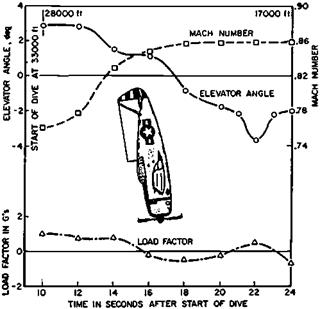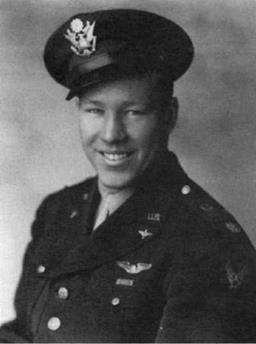P-47 Dive Tests at Wright Field
The Republic P-47 Thunderbolt was, like the P-38 Lightning, an important fighter airplane of World War II. Like the P-38, the P-47 had a supercharged engine and could climb to altitudes of about 35,000 feet and reach high enough airspeeds in dives to have compressibility effects on stability and control. The P-47 experience was sufficiently different
|
Figure 11.4 A Republic P-47 Thunderbolt fails to respond to 4 degrees of up-elevator in a dive at a Mach number of 0.86. (From Perkins, Jour. of Aircraft, July-Aug. 1970) |
from the P-38’s to merit retelling (Perkins, 1970). Following split S entries to vertical dives at 35,000 feet, the P-47’s nose would go down beyond vertical. No recovery seemed possible even with full-back stick and nose-up tab (Figure 11.4). At 15,000 feet high normal acceleration would suddenly come on, and airplanes would recover at 20,000 feet, with bent wings.
Three possible reasons for this were examined in a 1943 conference held at the NACA Langley Laboratory:
1. ice formation on the elevator hinges at 35,000 feet;
2. elevator hinge binding due to loads;
3. Mach number effects on stability and control.
As Perkins recalls, it was Theodore Theodorsen, the eminent NACA mathematician and flutter theorist who championed ice on the hinges as a possible cause for the problem. The NACA structures researcher Richard V Rhode proposed elevator hinge binding as the cause. Robert Gilruth and the forceful John Stack claimed correctly that it was all transonic aerodynamics. Quoting from the Perkins paper:
It became obvious that one simple test would resolve the major difference in the theories. When the pilot pulled on the stick, did the elevator go up or didn’t it? If it didn’t go up, then one of the first two theories would be correct; but if the elevator did go up and the airplane did not respond as it should, then the third theory would be the most likely answer.
The U. S. Air Corps at Wright Field agreed to run these tests and attempts were made to sign up a test pilot to perform the experiment. None of the contract test pilots were very anxious to do this and would have agreed only at very high fees. The problem was resolved when one of the Air Corps’s strongest and ablest test pilots, [Capt] P. [Perry] Ritchie [Figure 11.5] said he would perform the tests for nothing. He performed some thirty dive tests on an instrumented P-47 and his reward was an Air Medal.
|
Figure 11.5 Capt. Perry Ritchie (1918-1944), the courageous U. S. Air Corps test pilot who made 30 test dives in the P-47 Thunderbolt. (USAF photo) |
It was found at once that the elevator did go up to the predicted angle. However, while at that high airspeed the measured amount of elevator angle should have produced 20 to 30 g, the actual response was about 0.5 g, which appeared to the pilot as no response at all. This behavior was also found later by Republic Corporation test pilots. The P-47 was clearly experiencing the same Mach number phenomena as did the P-38. Compressibility burble on the inboard wing sections led to lift curve slope reductions and reductions in rate of change in downwash over the horizontal tail. This caused an increase in longitudinal static stability and a nose-down trim shift.
















